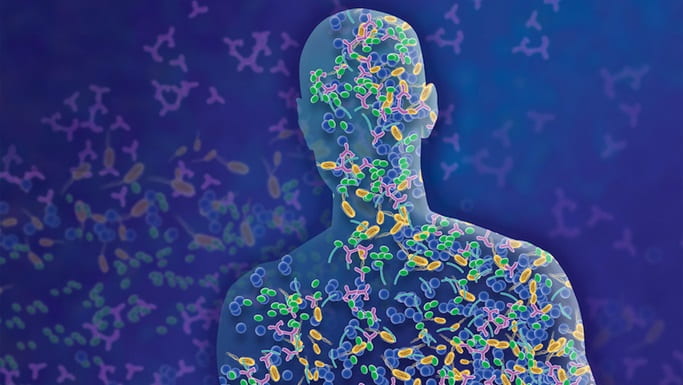Metabolomics is the field of biomedical research that studies metabolites produced by cells, including amino acids, lipids, carbohydrates, and more. Over the past several decades, researchers at the University of Chicago and elsewhere have begun to grasp how much characterizing these metabolites and measuring their levels can tell us about how biological systems respond to genetic differences, disease, or their environment.
Anticipating that faculty from different fields of investigation will be interested in defining metabolic profiles under different experimental and clinical circumstances, the Biological Sciences Division has invested in two distinct, but overlapping, facilities to conduct metabolomics analysis. The first, led by Eric Pamer, MD, the Donald F. Steiner Professor of Medicine and Director of the Duchossois Family Institute (DFI), specializes in metabolites generated by the microbiome, while the second (still in pilot phase), led by Ray Moellering, PhD, Associate Professor of Chemistry, accommodates all types of basic and applied research.
The Host-Microbe Metabolomics Facility (HMMF) at the DFI helps researchers measure, characterize, and identify the metabolites produced or modified by gut microbes. It’s one of three research platforms maintained by the DFI. The Microbiome Metagenomics Facility provides bacterial genetic sequence analyses on intestinal contents and other samples containing complex microbial populations, and the Symbiotic Bacterial Strain Bank contains more than 2,000 bacterial strains isolated from healthy human donors that have been cultured and characterized for research use. Each of these platforms is also supported by bioinformaticians who provide comprehensive computational data analyses, including genome assembly and annotation, using software to analyze genome sequences and characterize metabolite activity to better understand how commensal bacteria impact human health.
“We know the benefits and detrimental effects we derive from the microbiome are mediated by metabolites,” Pamer said. “They interact with our cells. They’re absorbed and circulate in the bloodstream. Some of them don’t do anything, but others do some pretty interesting things like stimulate the immune system or reduce inflammatory responses. In order to exploit these potential benefits, we need to be able to measure the metabolites, and that’s what metabolomics is all about.”
Moellering, a chemical biologist and proteomics expert, is leading the second effort in collaboration Kunle Odunsi, MD, PhD, the AbbVie Foundation Distinguished Service Professor of Obstetrics and Gynecology, Director of the Comprehensive Cancer Center, and Dean for Oncology, and Jing Chen, PhD, the Janet Davison Rowley Distinguished Service Professor of Medicine and Director of the Cancer Metabolomics Research Center. They are implementing metabolomics and proteomics capabilities to enhance cancer research and therapeutics. This new facility will also provide services and targeted research and development for all types of basic and applied research to foster interdisciplinary collaborations.
The heart of these facilities are mass spectrometers that can identify and measure metabolites from biological samples. In the past, researchers would have to analyze samples themselves in a user-run lab in the Department of Chemistry or ship them to an outside facility. Such vendors can be expensive and take months to process samples, whereas on campus facilities and equipment can turn around projects within a few weeks for a fraction of the cost. Dedicated staff can also provide consultations for investigators to assist them with proper sample collection, storage, and preparation.
Ashley Sidebottom, PhD, the Director of the HMMF, says this builds a competitive advantage for researchers at UChicago. “Since it’s a specialized facility, we have a critical mass of expertise because there is full-time staff here working on these samples and techniques all the time,” she said.
The HMMF lab has been up and running for about one year and has processed more than 10,000 samples so far, and the new metabolomics/proteomics facility hopes to begin accepting samples from researchers soon. These technology platforms open new possibilities for research that wouldn’t be possible without such expertise on campus. For example, last year researchers collected samples from patients with severe COVID-19 in the ICU and utilized the HMMF to categorize them based on their metabolite profiles. They discovered that there were a handful of metabolites they could measure to identify patients at highest risk for respiratory failure, suggesting that there might be a way to intervene and restore the right balance to stave off devastating illness.
“Two to three years ago, we didn’t know some of these metabolites were important or even existed, and now we know they’re correlated with health,” Pamer said. “Metabolomics is opening a door to a whole new spectrum of tests we can use to identify patients with susceptibilities that increase the risk for adverse outcomes and that may be preventable. That is exciting.”

